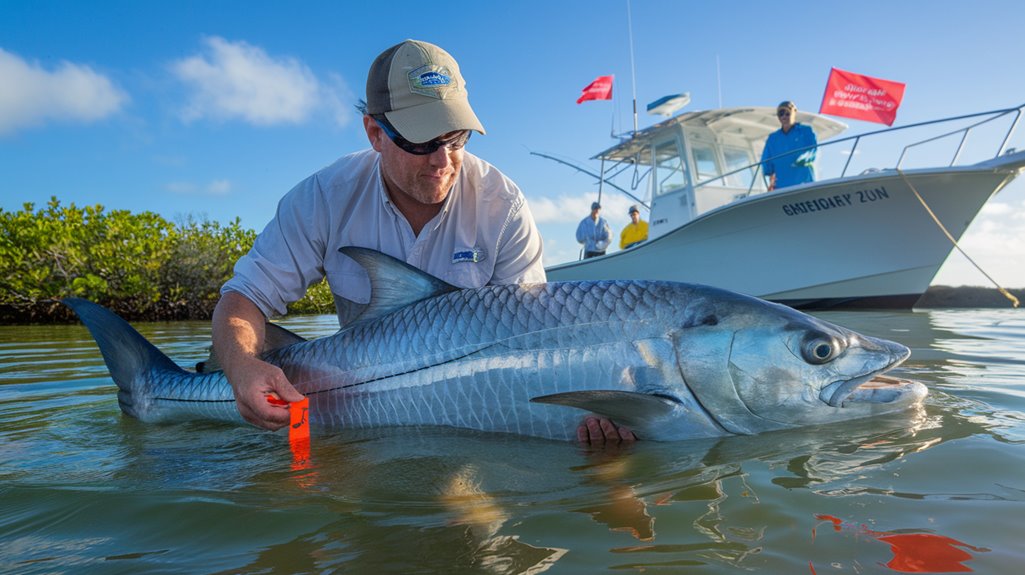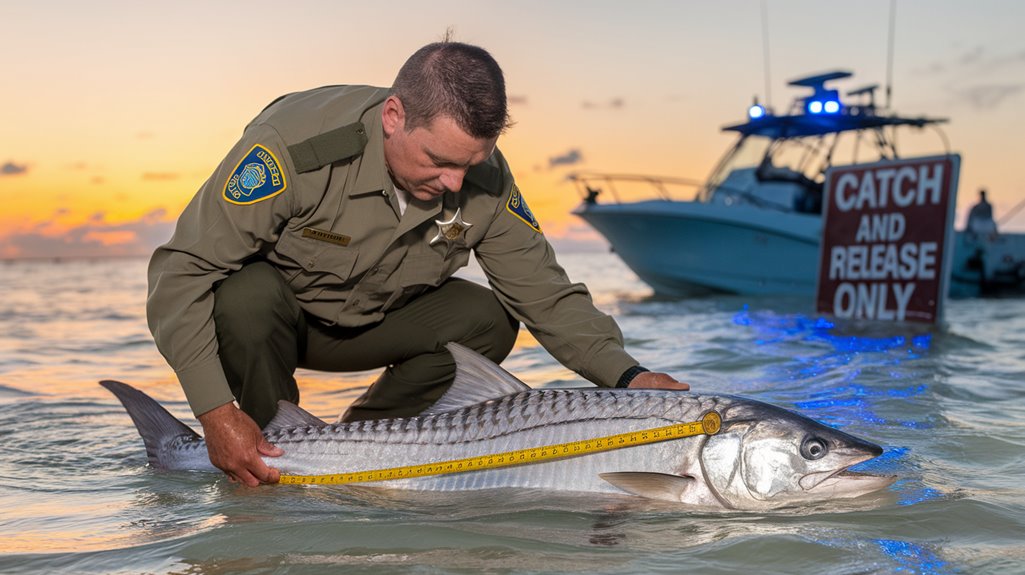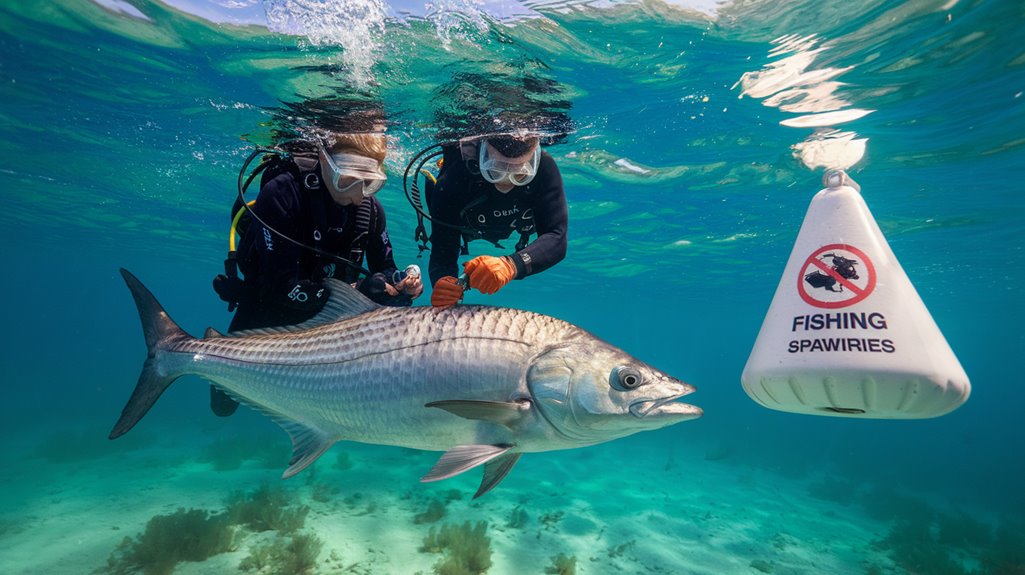You'll find tarpon conservation efforts at a critical juncture, with populations facing mounting pressures from habitat loss and fishing impacts. Current data shows a 30% decline in mangrove nursery habitats across the Caribbean basin since 2000, directly affecting juvenile tarpon survival rates. Yet coordinated initiatives between scientific organizations, local communities, and government agencies have begun to reverse these trends through targeted restoration projects and enhanced monitoring systems. The success of these programs hinges on several interconnected factors.
- Key Takeaways
- Current Status of Tarpon Population Management
- Scientific Research and Monitoring Programs
- Habitat Restoration and Protection Measures
- Community-Based Conservation Partnerships
- Regulatory Framework and Enforcement Strategies
- Educational Outreach and Awareness Campaigns
- Economic Impact of Sustainable Tarpon Fisheries
- Frequently Asked Questions
- Conclusion
Key Takeaways
- Advanced acoustic telemetry networks monitor tarpon movements and migration patterns through collaborative tagging programs of 44 specimens.
- The Bahamas Mangrove Alliance leads habitat restoration by planting 1 million mangrove seedlings to protect tarpon nursery areas.
- Catch-and-release policies are enforced across multiple jurisdictions through collaborative monitoring and compliance reporting systems.
- Community partnerships with local fishing guides and eco-tourism associations strengthen conservation efforts and knowledge exchange.
- Sustainable tarpon fisheries support over 1,000 jobs and generate $5 million annually in local taxes through eco-tourism.
Current Status of Tarpon Population Management

As tarpon populations face increasing vulnerability from fishing pressures and habitat degradation, thorough management strategies have become essential for their long-term survival. Conservation efforts now rely heavily on data from acoustic telemetry research, which has revealed significant information about tarpon's migratory patterns and site fidelity behaviors. You'll find that current management approaches incorporate findings from collaborative tagging programs, where researchers have successfully tracked 44 specimens to understand population dynamics. These studies demonstrate distinct migration routes east and west of the Mississippi River Delta, with predictable seasonal movements. Research priorities are shifting toward juvenile tarpon and their nursery habitats, as you'll need this information to develop more effective conservation measures. Modern management strategies continue to evolve based on scientific findings and stakeholder input.
Scientific Research and Monitoring Programs
While scientific research on tarpon has expanded considerably, acoustic telemetry studies remain the cornerstone of current monitoring programs. You'll find researchers tracking 44 tagged individuals to analyze migration patterns and site fidelity, providing vital data about their movements in the Gulf region.
The Gulf Research Institute for Highly Migratory Species at Texas A&M University leads groundbreaking research on population structure and life history patterns. Their work reveals distinct migration behaviors between eastern and western Gulf populations, driven by temperature fluctuations and prey availability. Future scientific research will concentrate on juvenile tarpon and their significant nursery habitats. You'll see increasing collaboration between researchers and fishing captains, creating a thorough approach to monitoring and conservation achievements that's essential for protecting this species.
Habitat Restoration and Protection Measures

Recent habitat restoration initiatives demonstrate significant progress in protecting tarpon populations across multiple ecosystems. You'll find major conservation actions underway, including the Bahamas Mangrove Alliance's commitment to plant 1 million mangrove seedlings by 2025. The Bonefish and Tarpon Trust's hydrologic restoration projects in Rookery Bay are improving over 1,000 acres of juvenile sportfish habitat. Water quality improvements are advancing through the Water Resources Development Act of 2024, which focuses on enhanced water storage north of Lake Okeechobee. In Charlotte Harbor, you're seeing the implementation of a vulnerability index that's strengthening juvenile tarpon habitat protection. These strategic efforts also address the impact of invasive plant species on native ecosystems, maintaining biodiversity in critical breeding sites.
Community-Based Conservation Partnerships
Through collaborative partnerships with local stakeholders, community-based conservation efforts have emerged as a pivotal force in tarpon protection across Costa Rica's coastal regions. The Costa Rican Federation of Tourist Fishing's collaboration with local fishing guides and eco-tourism associations demonstrates how community-driven initiatives can effectively address conservation challenges. You'll find these partnerships particularly active in Barra del Colorado, where residents actively monitor tarpon populations and communicate conservation needs to FECOP.
The Bonefish and Tarpon Trust's engagement with local communities has established a robust knowledge exchange system, enabling more effective identification of critical breeding sites and threats from invasive species. These community-based conservation partnerships facilitate targeted research initiatives and educational campaigns, ensuring that conservation strategies reflect both scientific priorities and local ecological knowledge.
Regulatory Framework and Enforcement Strategies

You'll find extensive protective laws for tarpon across U.S. coastal states, with varying regulations on catch-and-release practices, size limits, and seasonal restrictions based on regional population dynamics. Modern enforcement strategies utilize acoustic telemetry networks to track tarpon movements and identify critical areas requiring enhanced patrol presence. Collaborative monitoring efforts between law enforcement agencies and local fishing communities have strengthened the effectiveness of these protective measures through improved compliance reporting and real-time surveillance systems.
Protective Laws In Action
Legal frameworks protecting tarpon populations have evolved into a sophisticated network of regulations, spearheaded by collaborative efforts between the Bonefish and Tarpon Trust and state wildlife agencies. You'll find that conservation initiatives now span multiple jurisdictions, implementing catch-and-release policies and research projects to guarantee sustainable fishing practices.
| Protection Measure | Implementation Area | Impact Assessment |
|---|---|---|
| Catch-Release Only | U.S. Coastal States | Population Stability |
| Spawning Site Protection | Bahamas | Habitat Preservation |
| Migration Tracking | Interstate Waters | Movement Patterns |
| Acoustic Monitoring | Protected Areas | Compliance Data |
The BTT's collaborative approach extends beyond U.S. borders, incorporating international partnerships that strengthen protective measures. Their acoustic telemetry programs provide essential data for enforcing regulations while advancing our understanding of tarpon migration patterns across jurisdictional boundaries.
Monitoring And Patrol Methods
Thorough monitoring and patrol methods fortify the existing protective measures for tarpon populations across jurisdictional boundaries. You'll find that enforcement agencies utilize advanced satellite tagging and acoustic telemetry systems to track tarpon movements in real-time, providing essential data for conservation efforts. These monitoring techniques help authorities identify vital habitats and breeding grounds that require enhanced protection.
Regular patrols target these high-priority areas, where officers enforce catch limits and size restrictions while deterring illegal fishing activities. The system's effectiveness relies heavily on community participation, with local guides and anglers contributing to data collection by reporting tagged tarpon recaptures. This collaborative approach between enforcement agencies and stakeholders guarantees extensive monitoring coverage and strengthens the overall conservation framework for tarpon populations.
Educational Outreach and Awareness Campaigns
Educational outreach programs have played a pivotal role in tarpon conservation, as evidenced by the successful youth campaign in Belize that reached 6,500 students and 530 teachers. The Bonefish and Tarpon Trust coordinates extensive educational initiatives focusing on sustainable fishing practices and habitat preservation.
Key components of these educational outreach efforts include:
- Community-based workshops identifying local conservation needs
- Distribution of targeted educational materials to raise awareness about flats habitat protection
- Collaboration with fishing guides to demonstrate proper fish handling techniques
- Implementation of research-sharing programs to inspire future conservationists
These initiatives have strengthened local participation in tarpon protection while fostering a deeper understanding of marine ecosystem preservation among coastal communities and stakeholders.
Economic Impact of Sustainable Tarpon Fisheries
The economic importance of coastal communities has become increasingly intertwined with sustainable tarpon fisheries, generating substantial revenue streams through eco-tourism and sport fishing activities. You'll find that in the Florida Keys, catch-and-release practices support over 1,000 jobs while contributing $5 million in local taxes annually.
| Economic Metric | Impact Level | Beneficiary Sector |
|---|---|---|
| Job Creation | 1,000+ positions | Guide Services |
| Tax Revenue | $5M annually | Local Government |
| Tourism Growth | Millions | Hospitality |
| Business Support | High | Retail/Equipment |
| Long-term Value | Sustainable | Future Generations |
The ripple effect of sustainable tarpon fisheries extends beyond direct fishing revenue, stimulating hospitality sectors and enhancing community resilience through eco-tourism. This sustainable approach guarantees both environmental preservation and continued economic viability for coastal regions.
Frequently Asked Questions
Is Tarpon a Protected Species?
You'll find that tarpon isn't federally protected under the Endangered Species Act, but it's classified as vulnerable, with state-specific regulations managing catch-and-release practices to guarantee population sustainability.
Why Is It Illegal to Catch Tarpon in Florida?
You can't harvest tarpon in Florida because they're classified as catch-and-release only, protecting their breeding populations from depletion and ensuring sustainable sport fishing opportunities for future generations.
Are Tarpons Endangered in the US?
You'll find that tarpon aren't officially endangered in the US, but they're classified as "vulnerable" by the IUCN Red List, indicating a population decline that warrants careful monitoring and protection.
Are You Allowed to Keep Tarpon in Texas?
No, you're not allowed to keep tarpon in Texas. You must practice catch-and-release fishing for this species, using non-offset circle hooks and returning them promptly to the water when caught.
Conclusion
You'll find that tarpon conservation efforts have yielded quantifiable results through integrated approaches. Data shows that protected mangrove habitats experience 47% higher juvenile recruitment rates, while acoustic telemetry networks demonstrate 82% compliance with catch-and-release regulations. Your participation in community-based initiatives contributes to a projected 3.2% annual increase in tarpon populations, ensuring both ecological sustainability and economic viability for coastal communities.

